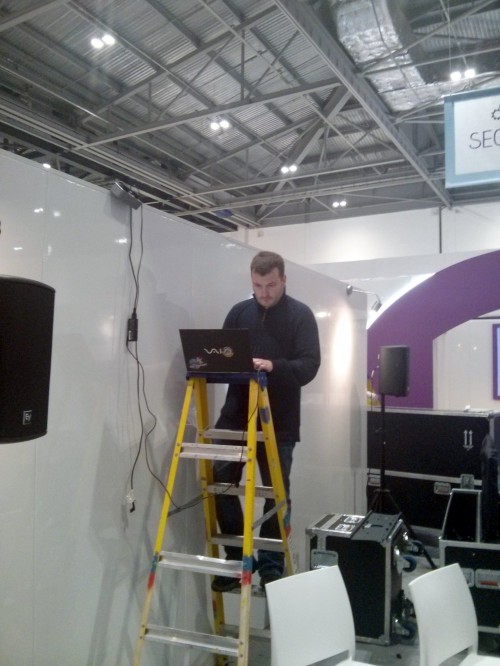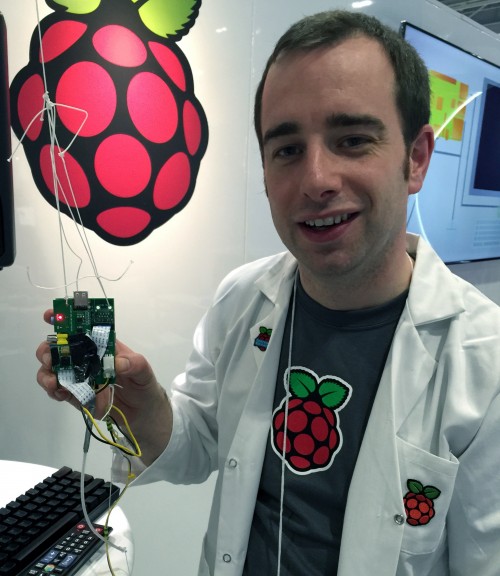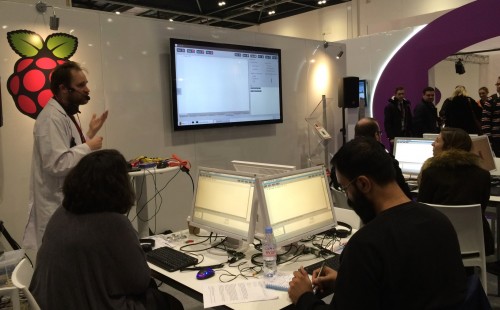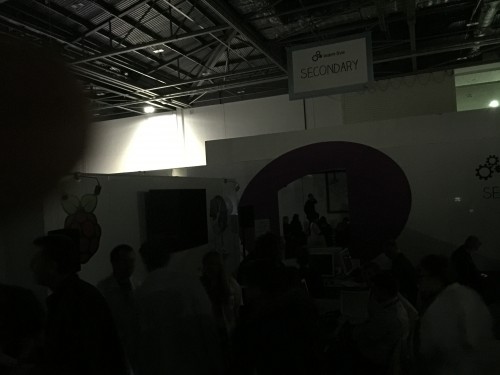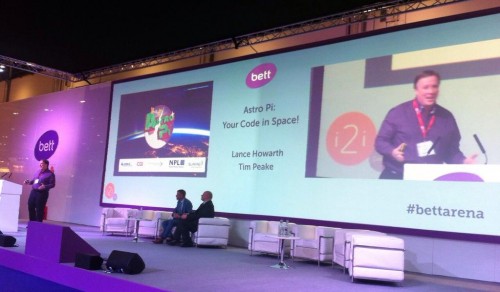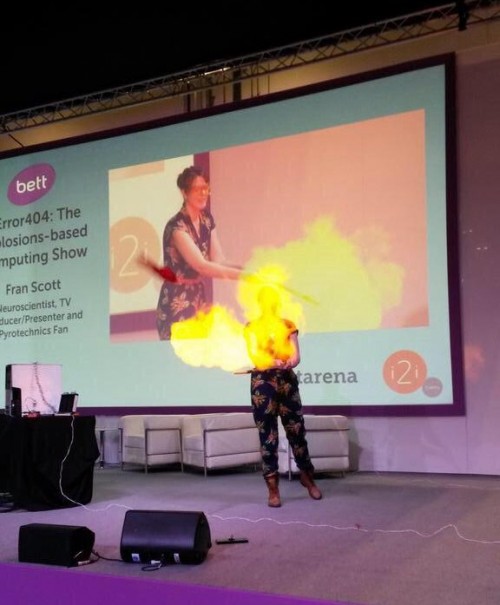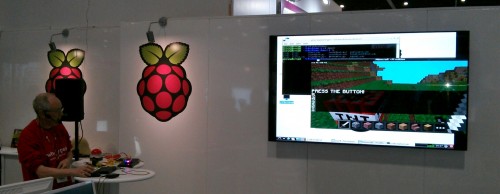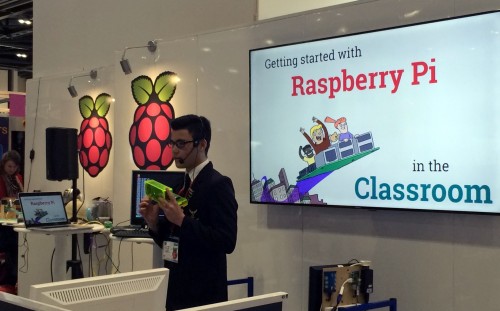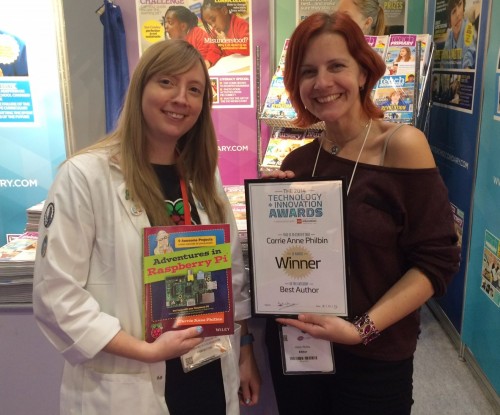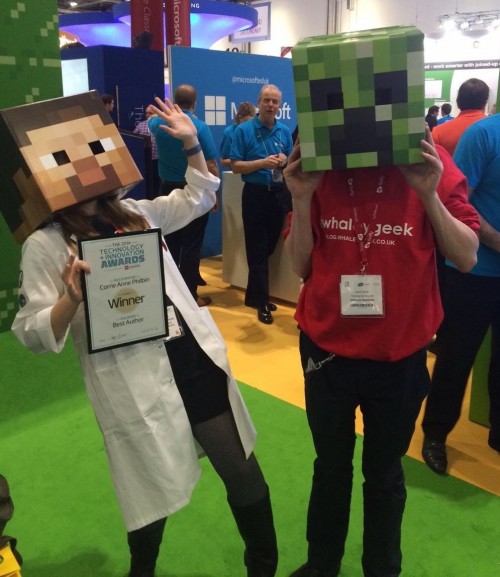|
Tesco has announced their intentions to close their digital e-Book platform at the end of February. The supermarket chain had been in covert negotiations with Waterstones, but the two sides could not agree on a purchase price. A spokesperson for Tesco said: "We have taken the decision to close our e-book service blinkbox Books. We’ve learnt a lot since launching the service and whilst we saw encouraging levels of take up, we believe that we can do more for our customers by focusing on our core business. The service will close by the end of February." The spokesperson added: "Our focus now is on the colleagues affected and our customers." Tesco had been operating their online bookstore since March 2014. They tried to promote their new business unit to their established base of shoppers, leveraging their loyalty cards to get discounts. Not only could customers buy e-books on their website, which included a book blog, but also via their dedicated Android app. This app was available via Google Play, but also came pre-loaded on the Hudl line of budget tablets. Ultimately the customer will be the one to suffer from blinkbox books shutting down. The app locked content will be unable to be backed up properly and read on any other device. Tesco has not publicly divulged if they will continue to support the app for the foreseeable future or whether they will close it entirely, leaving thousands of customers unable to read their purchased content. Blinkbox Books to Close in February is a post from: Good e-Reader |
A Semi-automated Technology Roundup Provided by Linebaugh Public Library IT Staff | techblog.linebaugh.org
Monday, January 26, 2015
Blinkbox Books to Close in February
Digital Content Connects Business Travelers
|
New data on travel, specifically the numbers that pertain to business travel, may provide a correlation between the increase in individual trips and the steady increase in popularity of digital newspaper and magazine apps. Numbers from the Travel Industry Association of America indicate that:
With so much travel taking place in far flung destinations when the individual is required to travel, one of the small comforts that airports and hotels have been able to offer is access to internet connectivity and digital magazines and newspapers. This allows the business traveler to connect to content and news from back home, rather than experience the sense of relief from getting away from it all, as when on vacation. “With todays' competitive hospitality industry, retention is usually a result of high guest satisfaction,” explains the logic behind digital amenities as offered by digital content app PressReader. “Value added guest amenities, like PressReader, give hoteliers an ideal solution to gain a competitive edge in the market resulting in higher guest satisfaction and repeat visits. With a library of over 2,000 same-day digital newspapers and magazines including the Washington Post, Elle Magazine, Business Traveler, The Globe and Mail and Le Monde, PressReader is a cost-effective luxury amenity that leisure and business travelers alike would appreciate.”
Digital Content Connects Business Travelers is a post from: Good e-Reader |
URL: http://goodereader.com/blog/digital-publishing/digital-content-connects-business-travelers
iPhone 5 vs iPhone 6 Plus – Reading
|
Many people skip a generation before buying the latest and greatest Apple product. The S line of smartphones tends to get lost in the shuffle between major updates in technology. With the advent of the iPhone 6 Plus, the question is, is it good for e-reading? Today, we look at the iPhone 5 and 6 Plus and put them side by side showing the exact same content. This should give you an indication on how both devices handle manga, comics and e-Books. If reading is important to you and you tend to be invested in the whole Apple ecosystem, you don’t want to miss this!
iPhone 5 vs iPhone 6 Plus – Reading is a post from: Good e-Reader |
URL: http://goodereader.com/blog/electronic-readers/iphone-5-vs-iphone-6-plus-reading
Video Update About Earl, an E Ink Survival Tablet
| Back in May 2013, a “backcountry survival tablet” named Earl with a 6-inch E Ink screen, solar panels, various radios and other goodies was introduced as part of a crowdfunding project. The goal was to earn $250,000 to make the Earl tablet a reality, but in fact expectations were far exceeded with over 2200 backers […] |
URL: http://feeds.the-ebook-reader.com/~r/feedburner/cmWU/~3/30jeFeEWyng/
Is the iPhone 6 Plus Good for e-Reading?
|
The iPhone 6 Plus is the first large screen phone that Apple has ever released and is quite excellent at reading e-Books, comics, manga and staying on top of the daily news. Unlike iPhones of the past, the 6 Plus actually makes the process of digital reading very enjoyable. The 6 Plus by Apple features a 5.5 inch display with a resolution of 1080 x 1920 pixels and 401 PPI. The sheer size of the screen and high resolution makes reading HD content extremely viable, such as comics and magazines. It is important to note that if you are consuming a large portion of this type of media to invest in an iPhone 6 Plus with more memory, because the average HD comics for example is around 150 to 250 MB. The base 16 MB model might not cut it. I have been a Blackberry user for a number of years, so reading on my phone has never really been a viable option. The square screen really prevented landscape mode, which a lot of e-reading apps require. Things improved when I bought my first iPhone 5 a few years ago, and started using news apps such as Digg and Thompson Reuters. The screen on the 5 was only 4 inches, which made reading e-books, magazines, newspapers and manga a lackluster experience. I found myself constantly having to pinch and zoom to find that virtual sweet spot, only to lose it when I flipped a page and had to reconfigure the zooming levels again. When I gravitated to the iPhone 6 Plus it really felt large and unwieldy for the first couple of days. I constantly found myself bending and flexing it to see if the entire “Bendgate” saga were true and to put my mind at ease that I was not going to bend the thing completely in half. I have never had an Android phone such as the Galaxy Note, so this was my first “Phablet.” Its now been a few weeks since I have been using the iPhone 6 Plus as my primary smartphone and find myself reading more on it than my Kindle. This is not because its new and therefore novel, but it can more easily install dedicated apps for the content I really like. My standard e-reading apps are Manga Rock, Crunchyroll Manga, Kindle, Zinio, Pressreader, Pulse Reader, Reuters, Digg Marvel comics. Almost all of these apps don’t even require pinching and zooming, all of the content really shines on the large screen. Do you come for a dedicated e-reader background? I am talking about e-ink based readers such as the Kindle, Kobo Nook or Sony readers. These brands for the most part have been going strong since 2007. These companies all realized early on that six inches made the ideal device, in terms of portability and overall e-reading experience. The iPhone 6 Plus is only half an inch smaller and is always in your pocket due to the fact it functions as your primary phone. In the video below, you will get a sense on how e-books, manga, comics and how dedicated news apps function on the iPhone 6 Plus. If you are on the fence about buying or upgrading to this model, watching this video should lend the assist.
Is the iPhone 6 Plus Good for e-Reading? is a post from: Good e-Reader |
URL: http://goodereader.com/blog/commentary/is-the-iphone-6-plus-good-for-e-reading
Join the first ever #ODchat – Jan. 28th
URL: http://feedproxy.google.com/~r/DigitalDistributionBlogOverdrive/~3/wLY10LoRL2M/
Self-Publishing the Family Cookbook
|
This has led to an increase in interest in private self-publishing, or a model of publishing in which an individual simply wants to have a professional-looking print or digital edition of a book that will not be listed for major sale. While outlets like CreateSpace function to list a professional-grade print copy on Amazon’s retail website, others like the addition of print services from Nook Press simply make print-on-demand copies available for the author to purchase. A recent article for Economic Times highlighted the need for cookbooks to have a publishing process, as more and more people are sharing their old family recipes within their group of relatives, and are looking for a professional option. While church cookbooks in particular have long been a fundraising option, the results were often shoddy plastic spiral bindings between two pieces of card stock, while the books themselves had to be ordered in minimum shipments of bulk that the organizations then had to turn around and sell at an astounding price, just to make a return. With print-on-demand, though, not only is the option available for single-purchase at much lower prices, the option to list the book on sites like Amazon is still there if organizations choose to direct their customers to the retailer and make their royalty that way. Of course, they are also free (and encouraged, even) to order their own copies at a significant savings and sell them at events as impulse purchases. In the case on the family cookbook featured in Economic Times, the book actually went on to be picked up by HarperCollins India, given that it was a large collection of regional favorites and nothing else like it was available at the time. The publisher has gone on to actively seek out other cookbooks for the same reason.
Self-Publishing the Family Cookbook is a post from: Good e-Reader |
URL: http://goodereader.com/blog/e-book-news/self-publishing-the-family-cookbook
Education, space, hacking and explosions – Bett 2015
| Last Tuesday the Raspberry Pi education team beetled down to the ExCeL London for Bett, the gargantuan learning technology event. We spent the next four days on our new and fabulous stand talking, educating, demo-ing, entertaining, showboating, dancing and gerrymandering. There were astounding demonstrations of technological ingenuity, feats of strength and curious electro-mechanical devices. 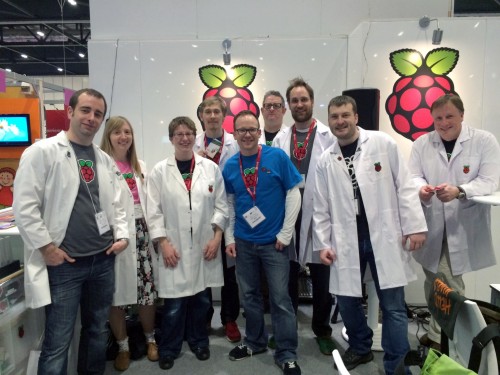 Ready for action: the education team plus James Robinson (leftest), Martin O’Hanlon (bluest) and Sam Aaron (tallest). Clive is weeping openly but laughing inside.
We were happily overrun by what seemed like most of the Raspberry Pi community, many of whom made guest appearances in our back to back schedule. We ran hands-on-workshops in Minecraft Pi, Sonic Pi, physical computing, games programming and much more. We stormed the BETT arena with Astro Pi and Fran Scott’s pyro-computing show. We ran about and hooted. It was a brilliant show. My post-show brain is far too fried to write so here are some of our favourite bits: James about to send up a time-lapse Pi on a helium balloon to spy on other stands.
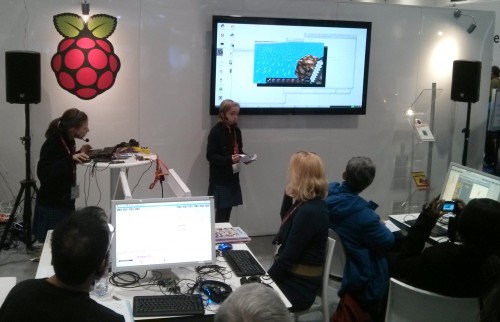 Laura Dixon’s (@codeboom) students from the Royal High School Bath talking about Minecraft coding and their computing club 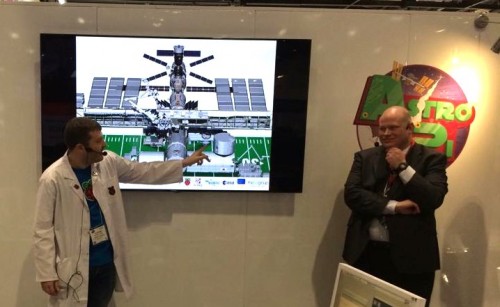 Dave Honess introducing Astro Pi and the ISS. His pitch-roll-yaw demo is now legend “My favourite moment was being rushed for Astro Pi leaflets at the end of the opening ceremony of the main arena. I have a great feeling about this whole thing” — Dave Honess Of course it’s not so easy to blow up stuff in the classroom so we made a safe version, the Balloon Pi-tay Popper: 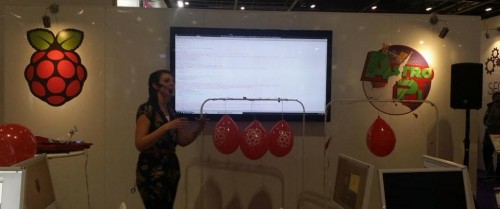 Fran demonstrating the explosive-free Balloon Pi-tay popper resource. 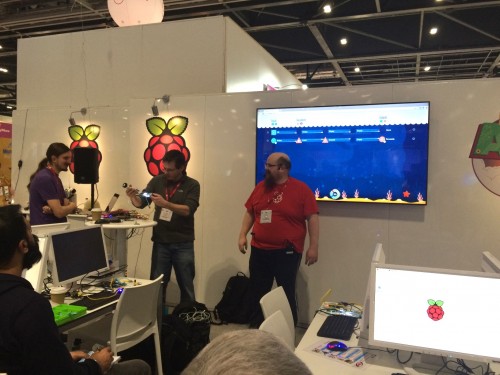 Our friends from Pimoroni show off their brilliant Flotilla 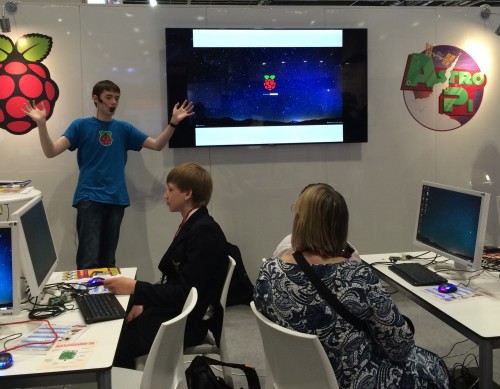 Andrew Mulholland, a student at Queen’s University Belfast, and his LTSP classroom management system for Raspberry Pi 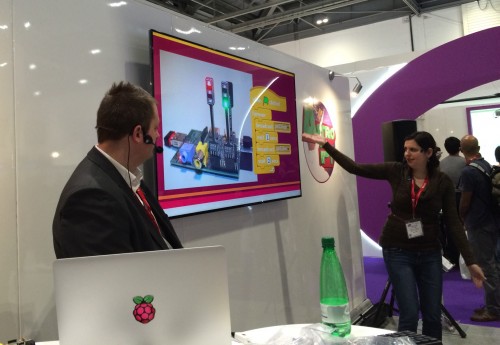 Raspberry Pi Certified Educators Cat Lamin and Tom Sale show how easy it is to use Pis in primary schools And that was that. Four days of manic educational goodness. Thanks to CPC for supporting us, we couldn’t have done it without them. We had a fabulous stand and a great team across the way to give hardware advice and support. A huge thanks to everyone who gave talks and demos and who helped out on the stand including: Sam Aaron, Laura Dixon, Martin O Hanlon, Alasdair Davies, Dave Honess & UK Space, Eliot Williams, Paul Beech, Jon Williamson, Phil Howard, David Whale, Tim Mockford, Simon Belshaw, Lauren Hyams, Fran Scott, Mike Horne, Tim Richardson, Jamie Mann, Matthew Parry, Cat Lamin, Tom Sale, Wolfram, Stephen Norbury, Naturebytes, Samantha Lubbe, Barry Byford, Karl-Ludwig Butte, Robin Newman, Andrew Mulholland, Spencer Organ, Geraldine Wright, Stewards Academy Raspberry Pi Club, and Cefn Hoile. If I’ve missed anyone then sorry and please email me! Lastly a big thank you to all of the teachers, students, parents, educators and anyone else who came to see us. See you again next year! |






